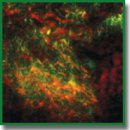
The Model of an Ischemic Non-Healing Wound: Regeneration after Transplantation of a Living Skin Equivalent
The aim was to evaluate the possibility of using our ischemic non-healing wound model for preclinical studies of biomedical cell products (BCP) during transplantation of a tissue-engineered construct.
The tasks of the study were to conduct the experiment on the transplantation of the tissue-engineered construct “living skin equivalent” (LSE) and select methods for determining the effectiveness of treating ischemic non-healing wounds during preclinical studies on the proposed model.
Materials and Methods. The study was performed on 56 BALB/c mice divided into the following groups: “control” (n=19), “scaffold” (n=19), and “LSE” (n=18).
During the experiment, the histological, immunohistochemical methods and raster scanning optoacoustic mesoscopy (RSOM) technique were employed to compare the dynamics of regeneration of ischemic non-healing wound using LSE transplantation, collagen-hyaluronic film as a cell scaffold, and a non-treated wound.
Results. Histology and immunohistochemistry have been found to be suitable to assess the effectiveness of treating ischemic non-healing wounds during preclinical investigations. The effect of LSE transplantation on infiltration of the wound bed with inflammatory cells, the formation of tissue in the wound bed zone, tissue condition at the wound margins, and angiogenesis has been studied. In addition, a new smoothing coefficient, i.e. the ratio of the thickness of the tissue-remodeling zone to the thickness of the dermis of the wound margins, has been proposed in the study. This coefficient makes it possible to assess the degree of filling the wound bed with the developing tissue. Its high value in the LSE group means that BCP transplantation influences the granulation tissue growth, prevents mechanical stress in the wound preventing thereby cosmetic defects.
Exploration of the regenerative processes has shown that the proposed model of the ischemic non-healing wound is suitable for preclinical studies of BCP.
- Xu F., Zhang C., Graves D.T. Abnormal cell responses and role of TNF-α in impaired diabetic wound healing. Biomed Res Int 2013; 754802, https://doi.org/10.1155/2013/754802.
- Zhang J., Yang X., Wang H., Zhao B., Wu X., Su L., Xie S., Wang Y., Li J., Liu J., Liu M., Han F., He T., Zhang W., Tao K., Hu D. PKCζ as a promising therapeutic target for TNFα-induced inflammatory disorders in chronic cutaneous wounds. Int J Mol Med 2017; 40(5); 1335–1346, https://doi.org/10.3892/ijmm.2017.3144.
- Eming S.A., Krieg T., Davidson J.M. Inflammation in wound repair: molecular and cellular mechanisms. J Invest Dermatol 2007; 127(3): 514–525, https://doi.org/10.1038/sj.jid.5700701.
- Zhao R., Liang H., Clarke E., Jackson C., Xue M. Inflammation in chronic wounds. Int J Mol Sci 2016; 17(12): 2085, https://doi.org/10.3390/ijms17122085.
- Vasiliev A.V. Kletochnye mekhanizmy reparatsii tkanevykh povrezhdeniy. Avtoref. dis. … dokt. biol. nauk [Cellular mechanisms of tissue damage repair. DSc Thesis]. Moscow; 2003.
- Lindblad W.J. Considerations for selecting the correct animal model for dermal wound-healing studies. J Biomater Sci Polym Ed 2008; 19(8): 1087–1096, https://doi.org/10.1163/156856208784909390.
- Morgun E.I. Dinamika protsessov reparatsii i kletochnoy gibeli v modeli ishemizirovannoy dlitel’no nezazhivayushchey kozhnoy rany u myshey. Avtoref. dis. … kand. biol. nauk [Dynamics of repair processes and cell death in a model of ischemic long-term non-healing skin wound in mice. PhD Thesis]. Moscow; 2021.
- Morgun Е.I., Rogovaya О.S., Vorotelyak Е.А. Ischemic non-healing skin wound model: cell death and wound healing mechanisms. Sovremennye tehnologii v medicine 2018; 10(4): 69–77, https://doi.org/10.17691/stm2018.10.4.08.
- Chermnykh E.S., Kiseleva E.V., Rogovaya O.S., Rippa A.L., Vasiliev A.V., Vorotelyak E.A. Tissue-engineered biological dressing accelerates skin wound healing in mice via formation of provisional connective tissue. Histol Histopathol 2018; 33(11): 1189–1199, https://doi.org/10.14670/hh-18-006.
- Han G., Ceilley R. Chronic wound healing: a review of current management and treatments. Adv Ther 2017; 34(3): 599–610, https://doi.org/10.1007/s12325-017-0478-y.
- Brenner D., O’Hara M., Angel P., Chojkier M., Karin M. Prolonged activation of jun and collagenase genes by tumour necrosis factor-α. Nature 1989; 337(6208): 661–663, https://doi.org/10.1038/337661a0.
- Dayer J. Beutler B., Cerami A. Cachectin/tumor necrosis factor stimulates collagenase and prostaglandin E2 production by human synovial cells and dermal fibroblasts. J Exp Med 1985; 162(6): 2163–2168, https://doi.org/10.1084/jem.162.6.2163.
- Salomon G.D., Kasid A., Cromack D.T., Director E., Talbot T.L., Sank A., Norton J.A. The local effects of cachectin/tumor necrosis factor on wound healing. Ann Surg 1991; 214(2): 175–180, https://doi.org/10.1097/00000658-199108000-00012.
- Wang X., Hsi T.S., Guerrero-Juarez C.F., Pham K., Cho K., McCusker C.D., Monuki E.S., Cho K.W., Gay D.L., Plikus M.V. Principles and mechanisms of regeneration in the mouse model for wound-induced hair follicle neogenesis. Regen (Oxf) 2015; 2(4): 169–181, https://doi.org/10.1002/reg2.38.
- Wang X., Chen H., Tian R., Zhang Y., Drutskaya M., Wang C., Ge J., Fan Z., Kong D., Wang X., Cai T., Zou Y., Wang J., Wang J., Wang S., Qin Z., Jia H., Wu Y., Liu J., Nedospasov S.A., Tredget E.E., Lin M., Liu J., Jiang Y., Wu Y. Macrophages induce AKT/β-catenin-dependent Lgr5+ stem cell activation and hair follicle regeneration through TNF. Nat Commun 2017; 8: 14091, https://doi.org/10.1038/ncomms14091.
- Li X., Dinish U.S., Aguirre J., Bi R., Dev K., Attia A.B.E., Nitkunanantharajah S., Lim Q.H., Schwarz M., Yew Y.W., Thng S.T.G., Ntziachristos V., Olivo M. Optoacoustic mesoscopy analysis and quantitative estimation of specific imaging metrics in Fitzpatrick skin phototypes II to V. J Biophotonics 2019; 12(9): e201800442, https://doi.org/10.1002/jbio.201800442.
- Nau T., Schönmann C., Hindelang B., Riobo L., Doll A., Schneider S., Englert L., He H., Biedermann T., Darsow U., Lauffer F., Ntziachristos V., Aguirre J. Raster-scanning optoacoustic mesoscopy biomarkers for atopic dermatitis skin lesions. Photoacoustics 2023; 31: 100513, https://doi.org/10.1016/j.pacs.2023.100513.










